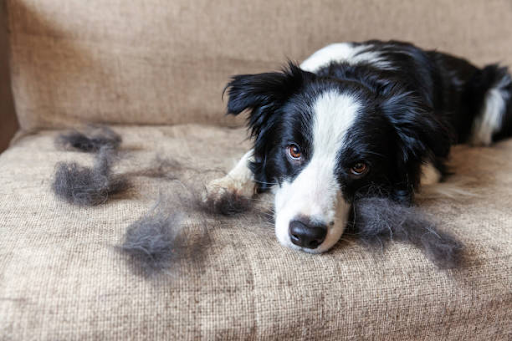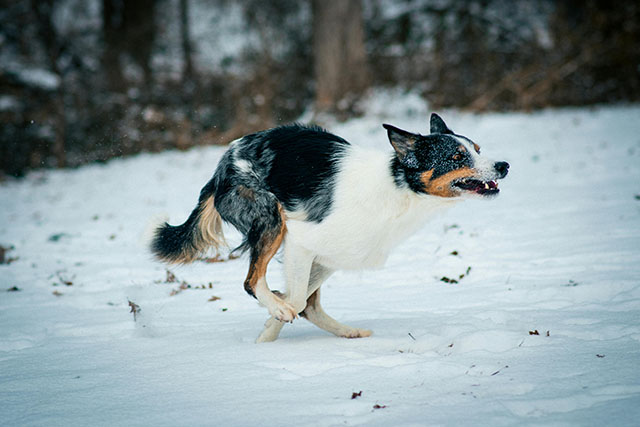It’s hard to love a dog with fur everywhere. If you have ever had the experience of getting up in the morning only to be greeted by your pet’s hair stuck to your socks and tucked under the couch cushions, then you know what it feels like.
But shedding is a natural process for all animals with fur – including dogs – and there are ways that we can help make living with our furry family friend easier on both ourselves and them. This blog post will present our top five tips for dealing with shedding in dogs so everyone can enjoy their canine companion as much as possible!
What Causes Shedding in Dogs?
Before we dive into our tips, let’s understand why our furry friends seem to be on a mission to cover every inch of our homes with their fur.
- Seasonal Changes: Shedding in dogs is often influenced by the changing seasons. Many breeds have a natural hair growth cycle that helps them adapt to temperature fluctuations. As the days get shorter and temperatures drop, your dog’s body might start preparing for winter by shedding its summer coat. Conversely, when spring arrives, they’ll shed their winter coat to make way for a lighter, cooler one.
- Breed-Specific Factors: Different dog breeds have different shedding patterns. Some breeds, like the Siberian Husky and the Alaskan Malamute, have double coats designed to keep them warm in cold climates. These breeds tend to shed year-round. Meanwhile, short-haired breeds like Beagles and Dalmatians may shed consistently but with less intensity.
- Hormonal Changes: Hormones significantly affect your dog’s coat health. Events like pregnancy, nursing, or reaching sexual maturity can trigger shedding. Diseases or hormonal imbalances can also lead to excessive shedding, so it’s important to keep an eye on your pup’s overall health.
- Nutrition and Diet: A balanced diet is essential for your dog’s skin and fur health. If your furry friend lacks essential nutrients like omega-3 fatty acids or zinc, their coat may become dry and prone to excessive shedding. Ensure your dog’s diet includes high-quality dog food, and consult your veterinarian for dietary recommendations.
- Stress and Anxiety: Just like humans, dogs can experience stress and anxiety, which may manifest in excessive shedding. Changes in their environment, routine, or even a new addition to the family can trigger stress-related shedding. Providing a stable and comfortable environment can help reduce this.
Now that we understand what causes shedding, let’s address the burning question: How can you stop it?
How Can I Stop My Dog From Shedding?
1. Regular Grooming Is Key
Grooming is your first line of defense against shedding. Regular brushing helps remove loose fur before it ends up all over your home. The frequency of grooming sessions depends on your dog’s breed and coat type.
- Long-Haired Breeds: Brush your dog at least three times a week to prevent matting and remove loose fur.
- Short-Haired Breeds: A weekly brushing session should suffice to keep shedding in check.
- Double-Coated Breeds: These pups require extra attention. Daily brushing can be a lifesaver during the heavy shedding seasons (spring and fall).
Ensure a positive grooming experience for your furry companion by choosing the right brush for their coat type. Treats and praise go a long way in strengthening the bond between you and your dog. This not only reduces shedding but also fosters a deeper connection. Use the FlexIt Dog Grooming Brush. With its dual functionality, time-saving features, and high-quality material, it’s a versatile and effective tool that is a must-have for dogs with double coats. The ergonomic design and easy-to-clean nature make grooming a breeze.
2. Maintain a Balanced Diet
As mentioned earlier, nutrition is vital to your dog’s coat health. Ensure your dog’s diet includes essential nutrients like omega-3 fatty acids, which promote a healthy coat. Look for dog food rich in these nutrients, or consult your vet for dietary recommendations.
3. Bathing and Moisturizing
Regular baths with a high-quality dog shampoo can help keep your dog’s skin and coat in top condition. Be cautious not to over-bathe, as excessive washing can strip the skin of natural oils and exacerbate shedding.
After bathing, you may use a dog-specific conditioner to moisturize the coat and alleviate dryness. This can be particularly beneficial for dogs more prone to dry skin and excess shedding. You can try the Pride and Groom Collection of Dog Shampoo & Conditioner for a great option. It’s specially formulated with essential oils and coat-specific ingredients to moisturize, soothe, nourish, and give your pup’s coat a beautiful shine.
4. Address Stress and Anxiety
If your dog is shedding excessively due to stress, it’s crucial to identify and address the underlying causes of their anxiety. Creating a stable environment, ensuring regular exercise, providing mental stimulation, and encouraging social interaction can all contribute to reducing stress levels in dogs.
In more severe cases, it is advisable to seek guidance from a professional dog trainer or veterinarian. Additionally, Solid Gold Calming Chews for dogs can be considered as they offer soothing relief for dog anxiety and stress, containing ingredients such as melatonin and valerian root. These treats are suitable for all breeds and sizes, helping with separation anxiety and fireworks-related anxiety. With 120 chews per container, they can be a valuable tool in promoting your dog’s wellbeing.
5. Consult Your Veterinarian
If you’ve tried these tips and your dog’s shedding persists or worsens, it’s time to consult your veterinarian. Excessive shedding can sometimes indicate an underlying health issue, such as allergies, thyroid problems, or skin infections. A vet can thoroughly examine and recommend appropriate treatments or medications if necessary.
How Long Does Dog Shedding Last?
The duration of shedding varies depending on several factors, including your dog’s breed, age, and overall health. Here’s a general guideline:
- Seasonal Shedding: For many dogs, seasonal shedding occurs twice a year, typically in the spring and fall. Depending on the breed and individual dog, this shedding can last anywhere from a few weeks to a few months.
- Year-Round Shedding: Breeds with continuous or year-round shedding, such as Labrador Retrievers or German Shepherds, will shed consistently but at a lower intensity than the seasonal shedders.
- Puppies and Seniors: Puppies often shed their puppy coats as they transition to adult coats. This shedding phase can last several months. Senior dogs may also experience increased shedding due to age-related factors.
Remember that individual variation is significant. Some dogs may shed more or less than others, even within the same breed. Regular grooming and proper care can help manage shedding regardless of its duration.
What Months Do Dogs Shed?
As mentioned, shedding in dogs is often tied to the changing seasons. Here’s a rough guideline for when you can expect your furry friend to shed:
- Spring: Many dogs shed their winter coat in the spring to prepare for warmer weather. This is often called “spring shedding” and can occur from March through May.
- Summer: During summer, shedding tends to decrease as dogs sport their lighter, warmer coats.
- Fall: In preparation for winter, dogs may shed their summer coat in the fall. This shedding phase, known as “fall shedding,” typically occurs from September to November.
- Winter: Shedding is generally minimal during winter, as dogs need their thicker coats to stay warm.
Remember that these are general guidelines and may vary depending on your dog’s breed, geographical location, and other individual factors. For more information on how often dogs shed, watch out for this video:
Taming the Fur: A Shed-Free Future with Your Canine Companion
Shedding is a natural and inevitable part of being a dog owner, but it doesn’t have to take over your life. You can keep your home and clothes relatively fur-free by understanding the causes of shedding, implementing regular grooming routines, maintaining a balanced diet, and addressing any stress-related issues.
Patience and consistency are key when dealing with shedding. With these five tips in your toolbox, you and your furry friend can enjoy a more comfortable, shed-free life together. Happy grooming!
Jessica is a veterinary medicine student who is passionate about animals. Living with her cherished dog, Milo, deepens her understanding of the human-animal connection, enhancing her empathy as a future veterinarian.
Jessica’s concise articles reflect her dedication to improving the lives of animals and those who care for them, making her an inspiring figure in the pet care field.







